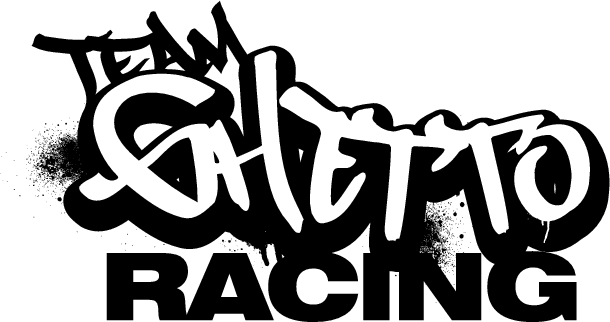Recommended Jimny mods
You get a lot of people asking about particular mod recommendations. Rather than continuing to repeat the advice, I’m going to try to keep my thoughts in some main categories here for frequently requested mods. Since I don’t work on getting free stuff for my opinions, I’ve tried to be unbiased; recommendations are based on my experience and time in the Jimny community instead of who’s paid or given me stuff.
This is vaguely in the order of amount of times the question gets asked, but there’s no grand scheme behind how I’ve put it together other than trying to cover off on many common questions.
Sections
- Tyres and wheels
- Suspension lifts/upgrades
- Bullbar
- Long range fuel tank
- Exhaust
- UHF/CB Radio
- Driving lights/auxiliary headlights
- Recovery points
- Roof storage
- Towbar/tow hitch
- Seat covers
- Floor mats, boot mat, dash mat
- Interior storage
- Recovery gear
- Underbonnet air compressor & mount
- Openable back windows
Tyres and wheels
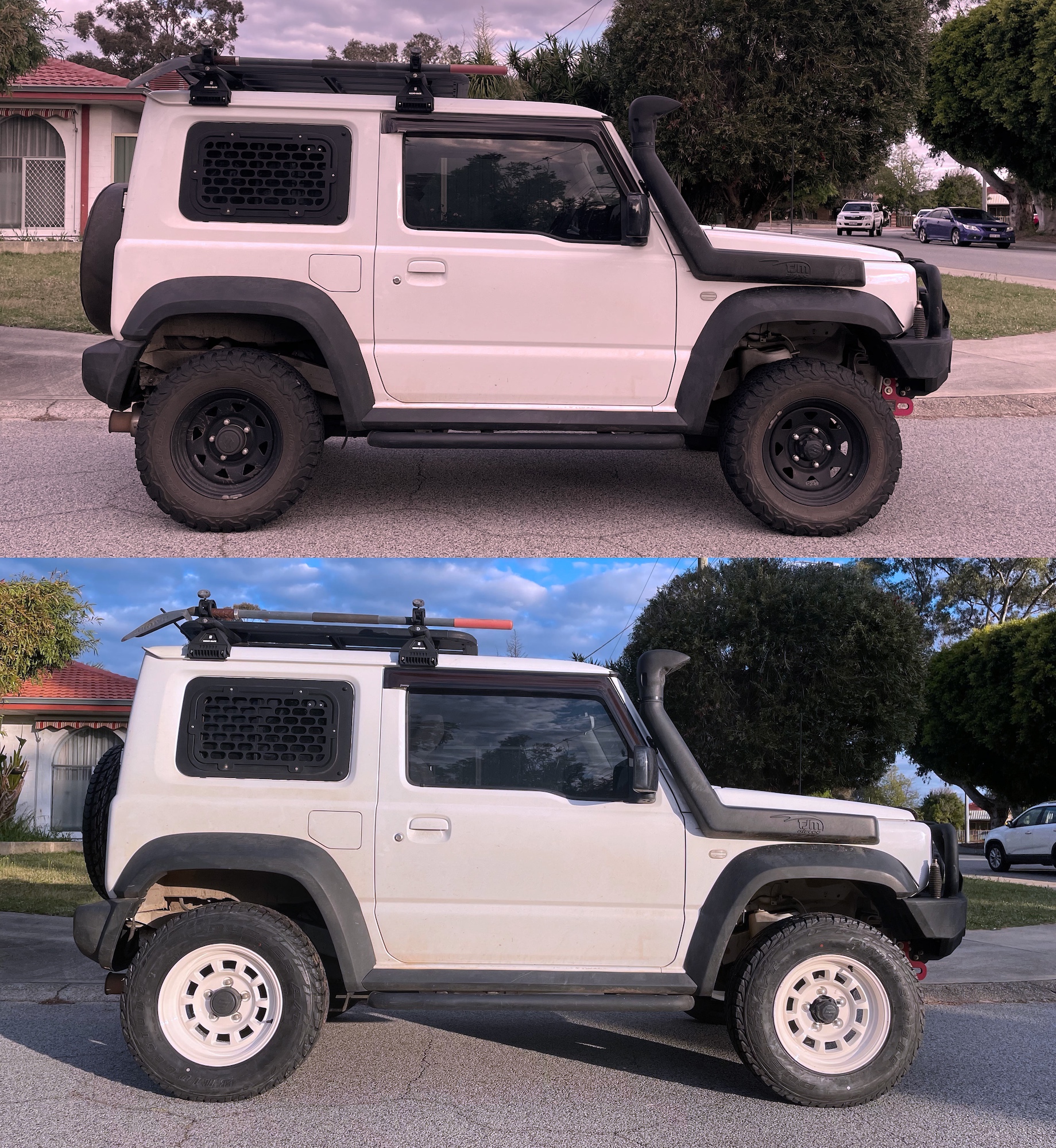
Big big big big big can of worms here. There’s too many options, so I’ll cover some considerations and some of my (late 2024) recommendations.
First off, there are wheel fitment questions: going beyond a 215 section tyre to a 225 or 235 section tyre means swapping out the factory wheels. While stock wheels are barely too narrow for wider than 215 section tyres, according to fitment rules they are. If you therefore desire to go to the max-legal-in-most-parts-of-Australia 29″ tyre then you potentially are looking for a set of replacement wheels as well as tyres, although some tyre shops will go outside fitment guidelines if you really want them to.
I think a lot of people prematurely upgrade the stock tyres which are surprisingly capable, especially for beach work and similar, so that’s another consideration: do you actually have to replace the tyres? It’s fine to do so even entirely just for looks, but it can be a much larger expense than you’re expecting.
- If you’re sticking to a stock tyre size and want more aggressive tread then the Toyo Open Country R/T in 195/80-15 is perfect; BFGoodrich are meant to release a KO3 allterrain in this size in early 2025 for another option.
- If you go to a 215/75-15 you barely increase size over stock (other than with) but you open up good tyre choices: I like a Bridgestone D697 as good everyday allterrain tyre; I ran BFGoodrich KO2s in this size for a number of years and they were fine, although many people find recent versions of this tyre pretty poor on the road in the wet; Kumho Road Venture AT52s are also another good tyre choice for this size.
- Going to 235/75-15 involves more compromises in terms of fuel economy and crawl speed but even more tyre choice. Again, a Bridgestone D697 is a great all-around tyre in this size; if you want ultimate aggressive allterrain and can deal with the weight then Maxxis AT811 is the main choice here.
- Since you potentially have swapped rims, consider going for a 16″ rim and running either a 235/70-16 or even a 205R16 for a 29″ overall diameter tyre. I did this and I love it as a size. Potentially a 205R16 can be lighter than a 235, and the narrow tyre look suits the Jimny. Once again D697s in this size work well, but you have a range of tyres designed for dual cab utes to choose from.
Wheel choice is even more varied, and rather than discuss the pros and cons I’ll direct you to my writeup on wheel and tyre upgrades for the Jimny to help your decision making.
Suspension lifts/upgrades
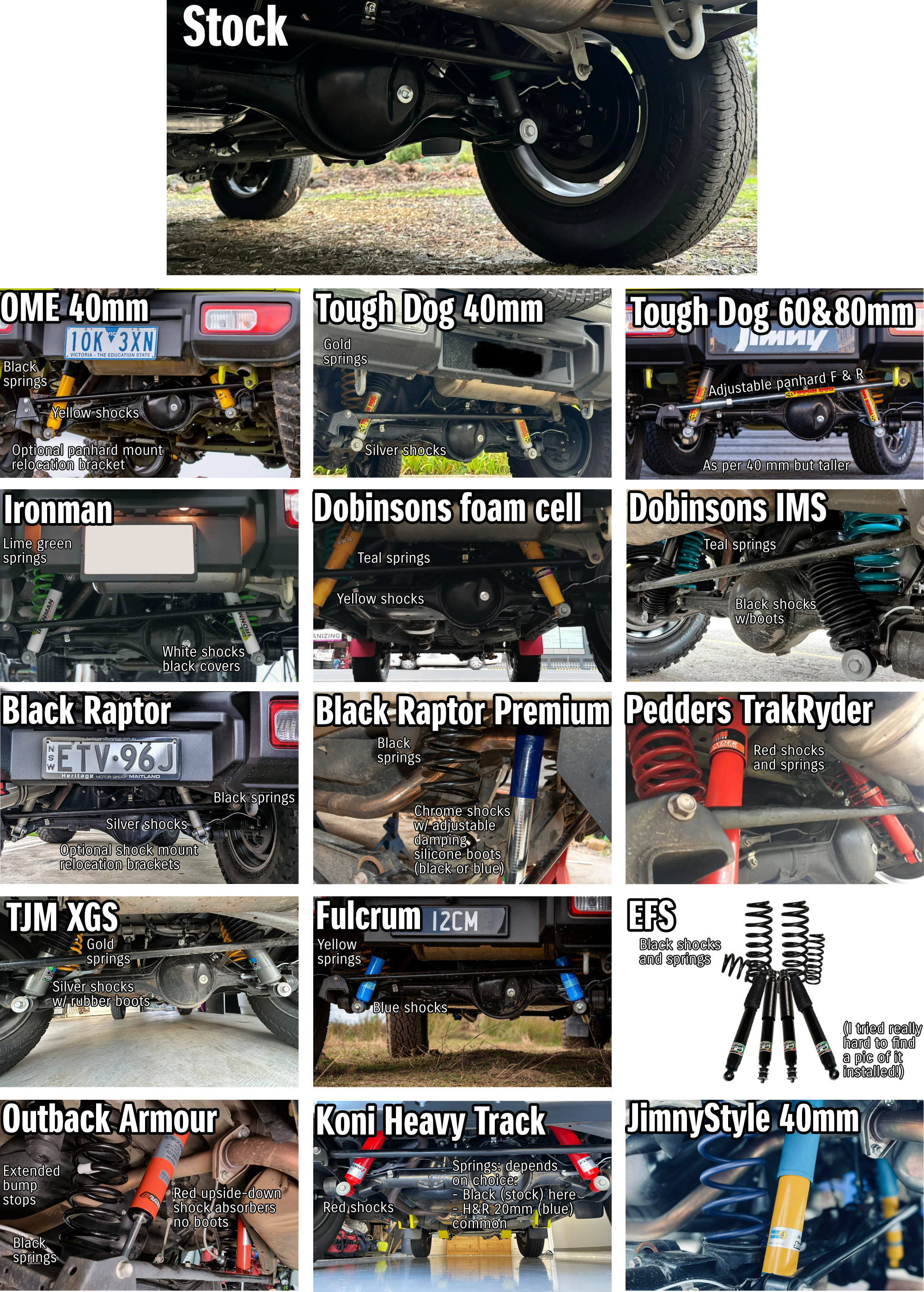
Prelude: thinking about your use of the car
The problem with lift selection advice is people general focus on everything other than the key thing: what do you want to do with your car? Upgrading the suspension is worthwhile in the Jimny due to the stock suspension being relatively average; normally you have compromises from getting a lift installed with the car on road but my experience is that they’re improved even with a 2″ lift. Once you go beyond that you start to hit more tradeoffs with the on road experience, but 2″ and below is generally no worse than stock even with the lift and theoretically the limitations they bring of a higher centre of gravity etc.
If you use the car mostly on the road then you can usually get away with the stiffer end of the spectrum; off road you want it as soft as you can get away with for the given load you’re carrying purely so you better articulate the suspension. That’s the first and major tradeoff. The other aspect is what’s available to you, especially in countries other than Australia, also can be a limiting factor. Since almost all lifts will end up a better experience for you than stock suspension then you can’t, to a degree, pick poorly here.
There are supporting things that are needed and different lifts do or don’t include them. Generally if you buy as a complete kit they will work ok out of the box, but any modifications from what is included might mean you need some other things. I’m working on a separate suspension glossary, but some quick notes on stuff to consider are below.
- Caster correction is not ‘essential’, but becomes more required as you go taller with a lift.
It depends on where the car was standard (they can vary a bit, although it isn’t adjustable from the factory) and the height of the lift. The more on the edge the car was standard, and the taller the lift go, the more likelihood you have of needing it.
Caster affects straight-line stability so if, after a lift, you find the car is not as stable as you want in a straight line then caster correction might be needed. Poor caster manifests itself as just following whatever last direction the car was steered in, which then people mask with things like upgrading the steering damper. That’s also usually not necessarily for up to a 2″ lift using semi-standard sized tyres. - Adjustable panhard rods are also not essential but depend where the car is after the lift. If the axles are significantly off centre then they are needed, but otherwise they aren’t and the car doesn’t hugely care about a few mm either way. I think 6mm off centre is a good ballpark for where you might want to think about it. Usually 2″ lift or below ends up with less of a difference than this
- Extended brake lines depend mostly on the extended length of the shocks you fitted. For most lift kits they are needed at the front only at 2″ lift or longer, though it is possible to have a shorter lift with longer shocks and end up needing them. Some kits require a rear line or two to be changed, but some accommodate this just by bending the brake line mount slightly (which is totally fine).
- If you have a 3 door with LED headlights then you will need some way to adjust where the headlight levelling sensor sits, either with an offset bracket or different arm.
- Generation 4 Jimnys have an additional cross-member for side impact stiffness, and at high amounts of droop at the front axle it is needed. If you fit caster correction to most 40mm lifts, or you go 45mm or beyond with a lift, usually you will need to space this crossmember down using brackets, or replace the crossmember entirely with one that has more downward clearance or even goes above the front propshaft instead of below it.
- ABS and vacuum line relocation brackets are a nice to have but not essential. It can be accommodated by slightly tweaking the factory brackets (my preferred method). Otherwise you risk ripping a vacuum line (killing the automatic front hub engagement) or ABS lines (expensive as you have to replace both sensor wires for that axle, not just one for the side that’s broken).
GVM or not to GVM, that is the question
A lot of people jump on the idea of a GVM upgrade for the Jimny, mostly thinking it’s essential. I’m not sold it is however you do need to bear in mind the weight carrying capacity of the Jimny. If you want a heavy setup with a lot of barwork, a big internal storage layout and/or want to do big overlanding trips then maybe you need it. Otherwise you can pick wisely for the weights for the accessories you have, and camp and pack light, and you don’t necessarily need it.
If you are considering a Jimny then it is worth accurately adding up the weight of all of the accessories you want to add to determine if you need a GVM upgrade. I go into this in a lot more detail over here discussing the legalities and choices you can make.
The GVM upgrades currently available for the 3 door Jimny all are based on the same suspension lifts you can buy without the certificate for a lot cheaper. If that paperwork matters to you then you have to pay, however, it isn’t like some of the larger 4wds where more substantial vehicle modifications are undertaken to accommodate the weight.
Recommended lifts / options
- If you want a good balance of on and offroad comfort, and aren’t going to routinely carry a heap of weight in the rear then I would get the OME 40mm lift through ARB.
- If you are more likely to be carrying a bit more weight in the rear then the Dobinsons 40-50mm lift, ideally with their IMS shocks, is a good choice
- If getting a GVM upgrade then it’s a coin toss between Tough Dog and Ironman, mostly down to the distributor/installer you’d prefer to do. In an ideal world get this pre-registration as that gives the most flexibility upon selling the car. One note: if getting the Ironman lift then I would be very sceptical about getting the constant load rear springs unless you are routinely exceptionally heavily loaded in the rear (think heavy drawer setup, large fridge, replacement steel rear bar).
- For adjustable shock absorbers and a good balance of on and off road performance get the Black Raptor Premium lift through Jimny Bits, which is the lift I run
- If you’re prepared to get a lift out of Japan then the Taniguchi 60 mm lift is another good choice for adjustable shock absorbers
- If you want to go very much past legal in Australia then HM4x4’s 80mm lift is probably your best option
- If you want to keep it roughly at stock height, the H&R 20mm springs and either Bilstein or Koni shock absorbers are probably a good choice. Another option here for springs would be the 15-20mm lift King Springs if you’re after a more Australian native option. Note that this ends up costing about the same to install as a taller lift and probably is less of a selling point on the used market, so for many people going something like the OME 40mm lift is a better choice.
Bullbar
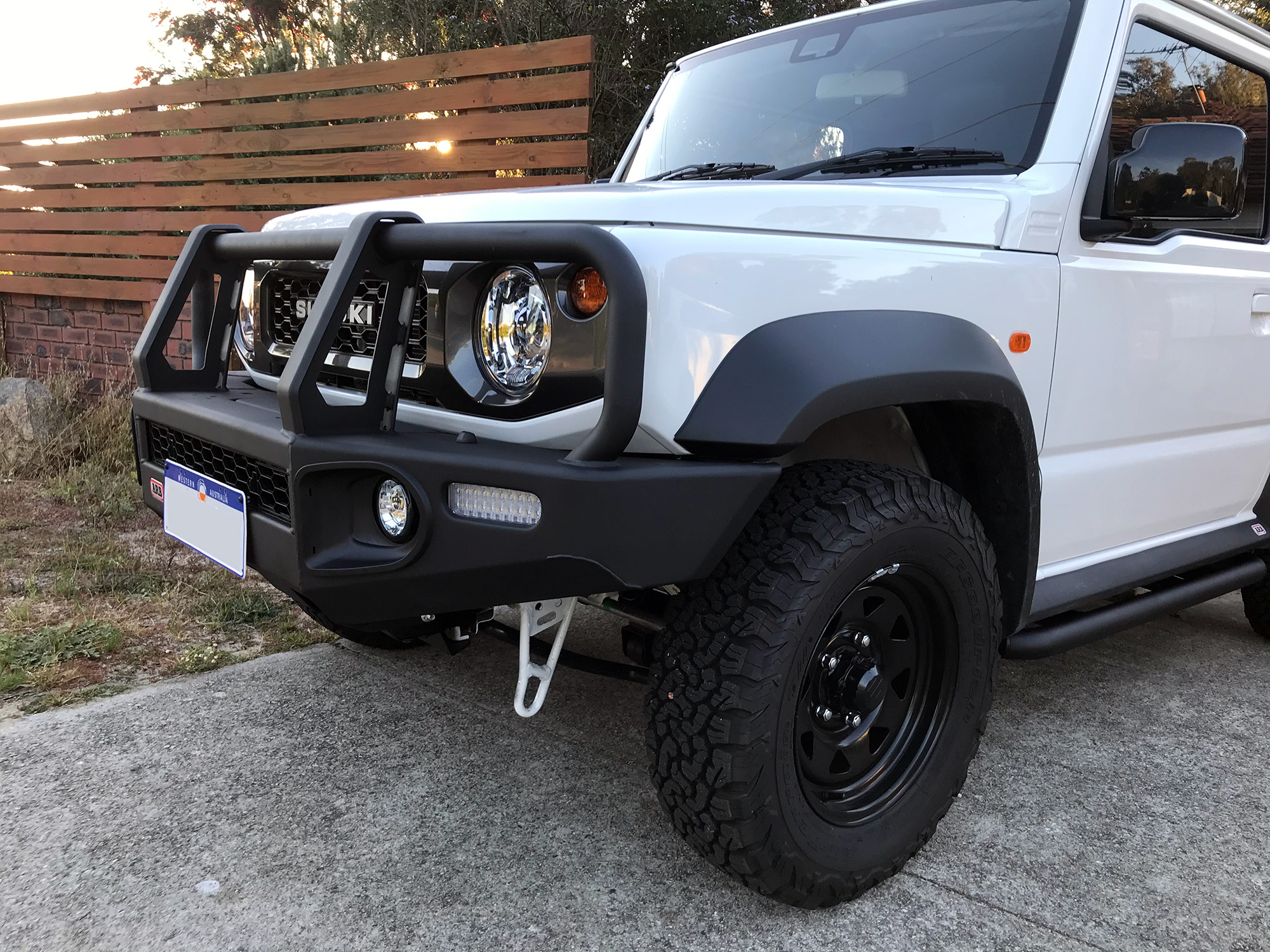
Controversial here: if you don’t need one because you don’t do a lot of night driving with more risk of animal strikes then don’t get one; the weight saving is worthwhile. If you want a winch (options discussed below) in this circumstance then get the HM4x4 hidden winch mount, which seems to be the best of the hidden winch options.
If you’re going for a bullbar then I would only recommend looped bullbars. You need to select carefully as some of them can weigh quite a lot more than others despite not actually adding any additional protection through the added weight. For a lot of people the ARB bullbar is the best choice, adding only 37 kg to the car. It’s the easiest to get through any ARB dealer and has proven to be very strong and well made. If you want something more unique but are prepared to deal with longer lead times and/or sorting your own shipping then the Raslarr bar would be the second choice, again because it only adds about 37 kg to the car.
Plenty of other bullbars out there add more like 55-60 kg to the car, so it is worth choosing wisely here.
Long range fuel tank
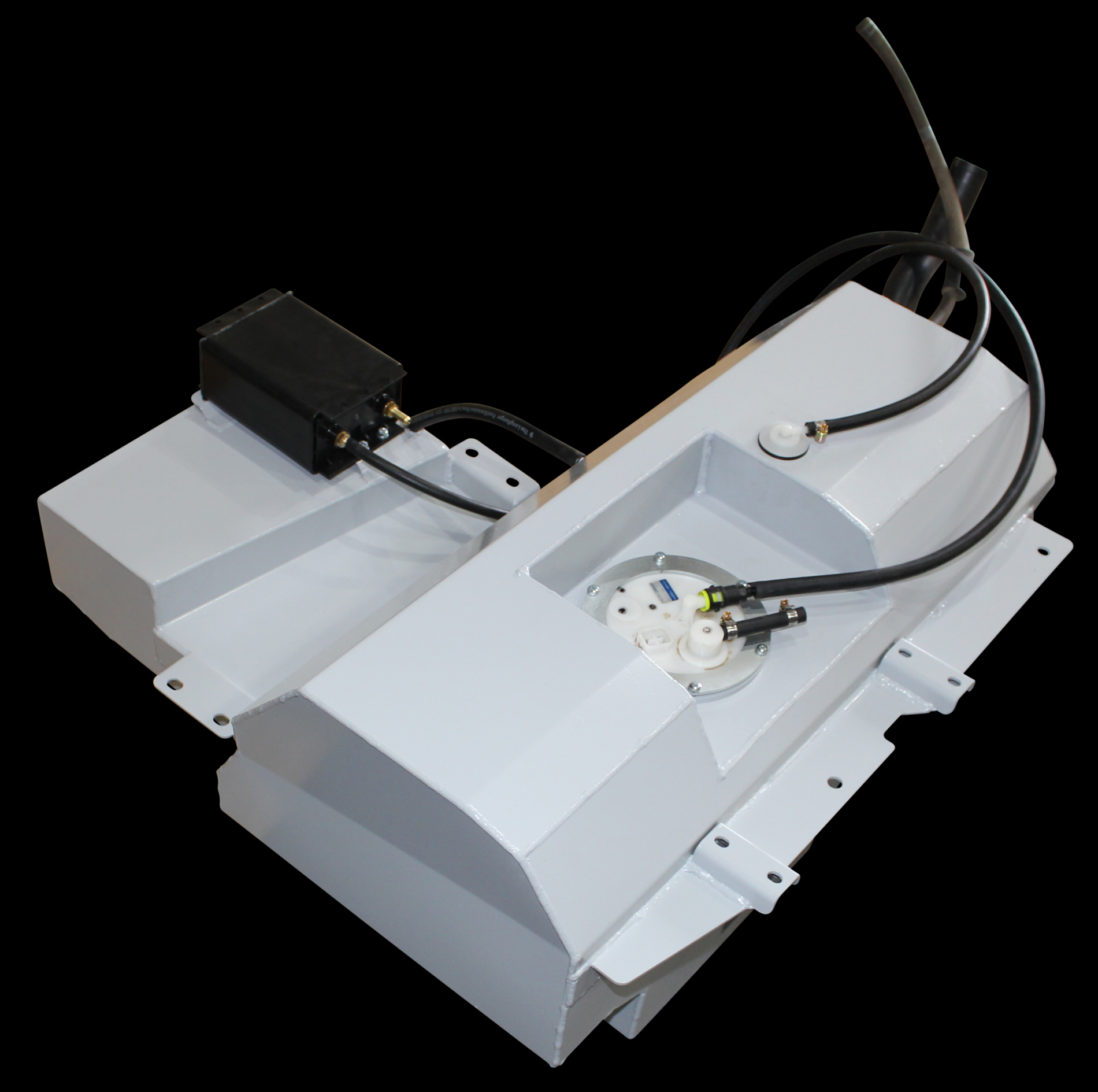
Three options, though I think one is the best for availability and simplicity. The option I first rule out is the Brown Davis auxiliary tank; it requires significant changes to the rear muffler to accommodate it, isn’t compatible with many towbars, carries only 30L and requires you to manually transfer the contents to the main tank. Outback Accessories have a replacement 80L tank but the main reason to get that is availability i.e. if you can’t get the first choice.
The first choice for me for the long range tank is the 80L Long Ranger fuel tank. They’ve had a bunch installed since release in 2020 so they are well tested. Because they are available through ARB stores as an agent for Long Ranger they’re also probably the simplest to get your hands on, too. I highly recommend them and would be doing one as one of my first mods if I was kitting up another Jimny.
Plenty of people will pipe up and just say get some jerrycans, but fundamentally they’re harder to carry on the Jimny and by the time you add some way to legally carry them you’ve either exceeded the roof load limit, put them in harms way at the back of the car or gone outside recommended carriage of fuel by sticking them in the cabin. I did that for a couple of years, and if you are going to do jerrycans then get genuine rotopax flat fuel cans for at least packing simplicity, but honestly the tank is just nice to have. Is it $2000 nice to have? That’s harder to say as it depends on your disposable income but I’d prefer to forego other mods and make the car better at touring the outback through fuel range than anything else.
Exhaust
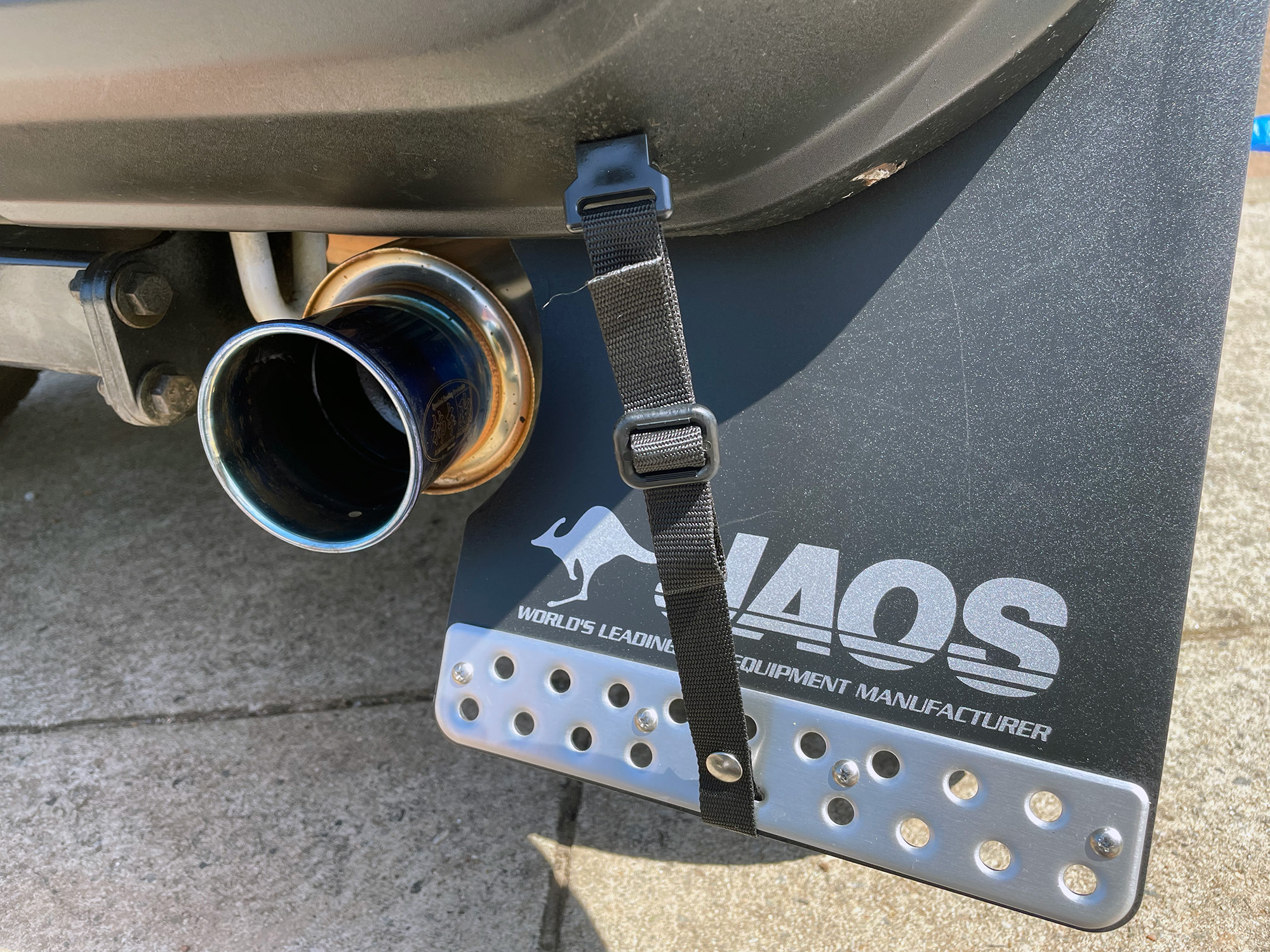
One of the changes required with a long range tank are adjustments to the exhausts, which brings people to wanting to change their exhausts for more performance and/or also noise. A couple of things:
- Without a tune, an exhaust swap doesn’t necessarily help to add power, especially if you replace only from the catalytic converter(s) back
- Although lots of people talk about ways to fool check engine lights, half-arsed solutions don’t seem to work well and people end up with random check engine lights, melted oxygen sensor cables and a bunch of other things.
My chosen exhaust modifications work well, namely using the AVO manifold with integrated first catalytic converter, the upgraded high-flow secondary cat, and a Kakimoto Japanese exhaust. If you wanted to replicate this then it’s not the cheapest way to do it, however, I would just get the Kakimoto rear section and have a custom exhaust shop modify the midpipe to accommodate a long range tank & delete any resonators/mufflers in this section. It’ll sound great without being raspy, and it’ll be a lot cheaper than bringing in the full exhaust which does require modification to make it work with the long range tank.
I struggle to advise people to get any of the 3 commonly available Australian exhausts/Australian brands. I have seen: too many questions around build quality, especially welding quality; customers used as R&D platforms to revise products; limited direct knowledge of good exhaust theory and design; very poor practises around either deleting cats or not understanding how to play nicely with the emissions system. I also really don’t like the raspy note a few of them have. I have, however, been happy with what I received from AVO in terms of the manicat headers. With no experience of it but based on that quality then perhaps their full exhaust system would be worth trying.
In terms of tuning to suit I think the only route is to get a custom tune. It’s well worth it. Off the shelf flash tunes end up being a bit one size fits all which isn’t necessarily ideal.
UHF/CB Radio
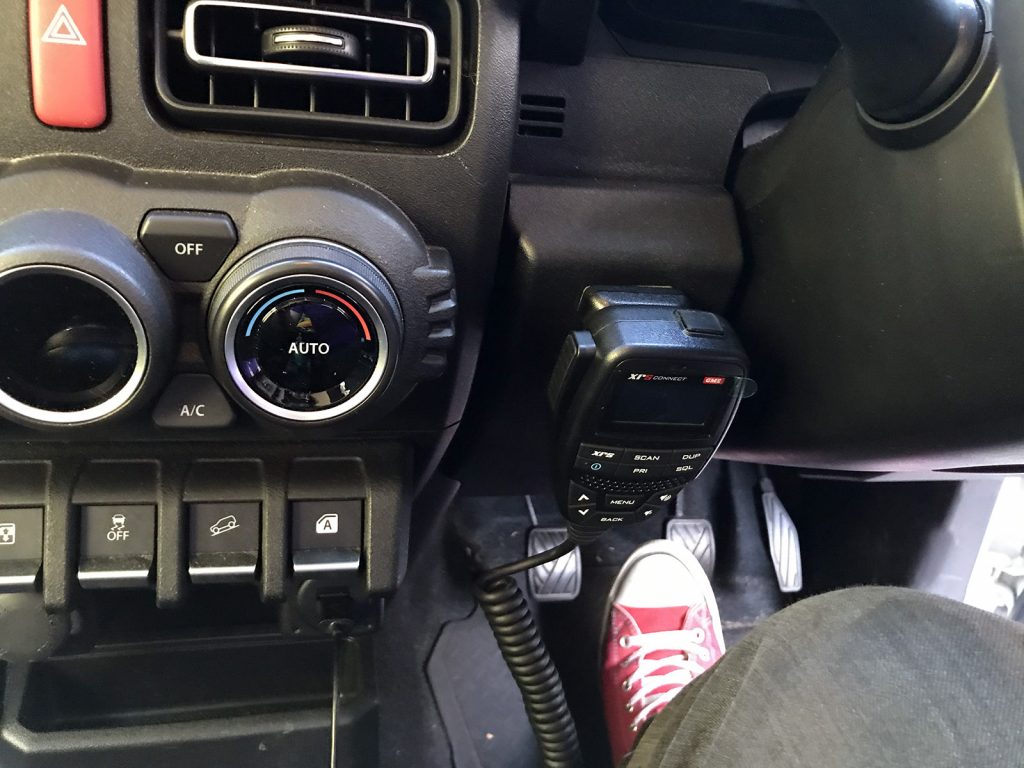
Short and simple version here is my preference remains the smallest GME XRS Connect unit, the XRS330C. Why? It’s a hideaway unit so you can tuck it anywhere; no point going for the other versions as they just add stuff like a speaker in the unit you’ve hidden away behind all your panels so what’s the point? All of the unit is controlled on the handset and it makes for the neatest and tidiest install. I’ve always found my GME radios to be incredibly reliable so I think they’re the best option.
For antenna placement, having a bullbar makes it easier. You can also get bonnet brackets, or mount it on a generic bracket off the IPF light stay if you went for that for your driving lights, a bracket off the spare wheel carrier, or even a rear boot hinge bracket.
Driving/auxiliary headlights
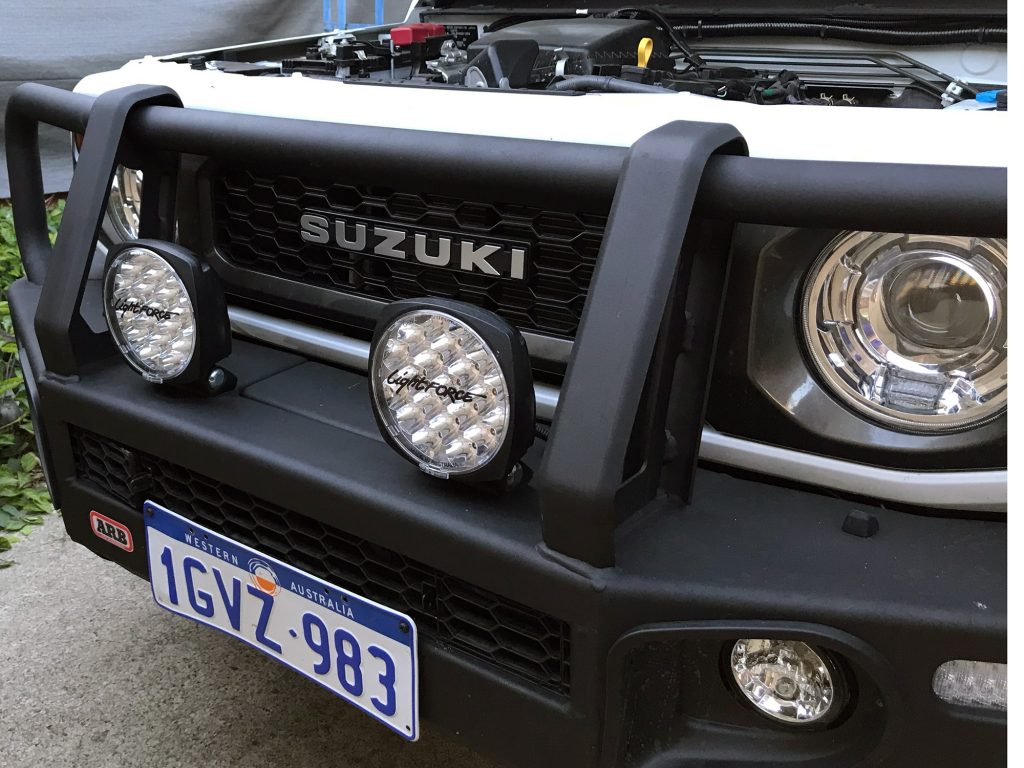
I actually don’t have a huge amount of advice on a specific thing here. I think better brands are worth it, and I bought my smaller Lightforce LEDs 2nd hand at a good price. The key thing I think is not going too big: 9″ ones look cool but block more airflow, and Jimnys can get marginal on cooling. This is especially so after a couple of years of hitting muddy trails, so unless you’re in the habit of routinely cleaning out the radiator then consider smaller headlights.
If you don’t have a bullbar, the IPF light stay seems like a good option to fit lights to your car.
Another option if you’re after a roof-mounted lightbar would be some gutter mounts. While a bunch of resellers have them, they’re almost all universally made in China and cheaper from aliexpress. They fit 52″ lightbars of which you have a heap of options on the markets.
Whatever you do with regards to lights, be warned that many piggyback connectors for the LED headlights are wired a bit incorrectly so might not work with your chosen wiring harness.
Recovery points
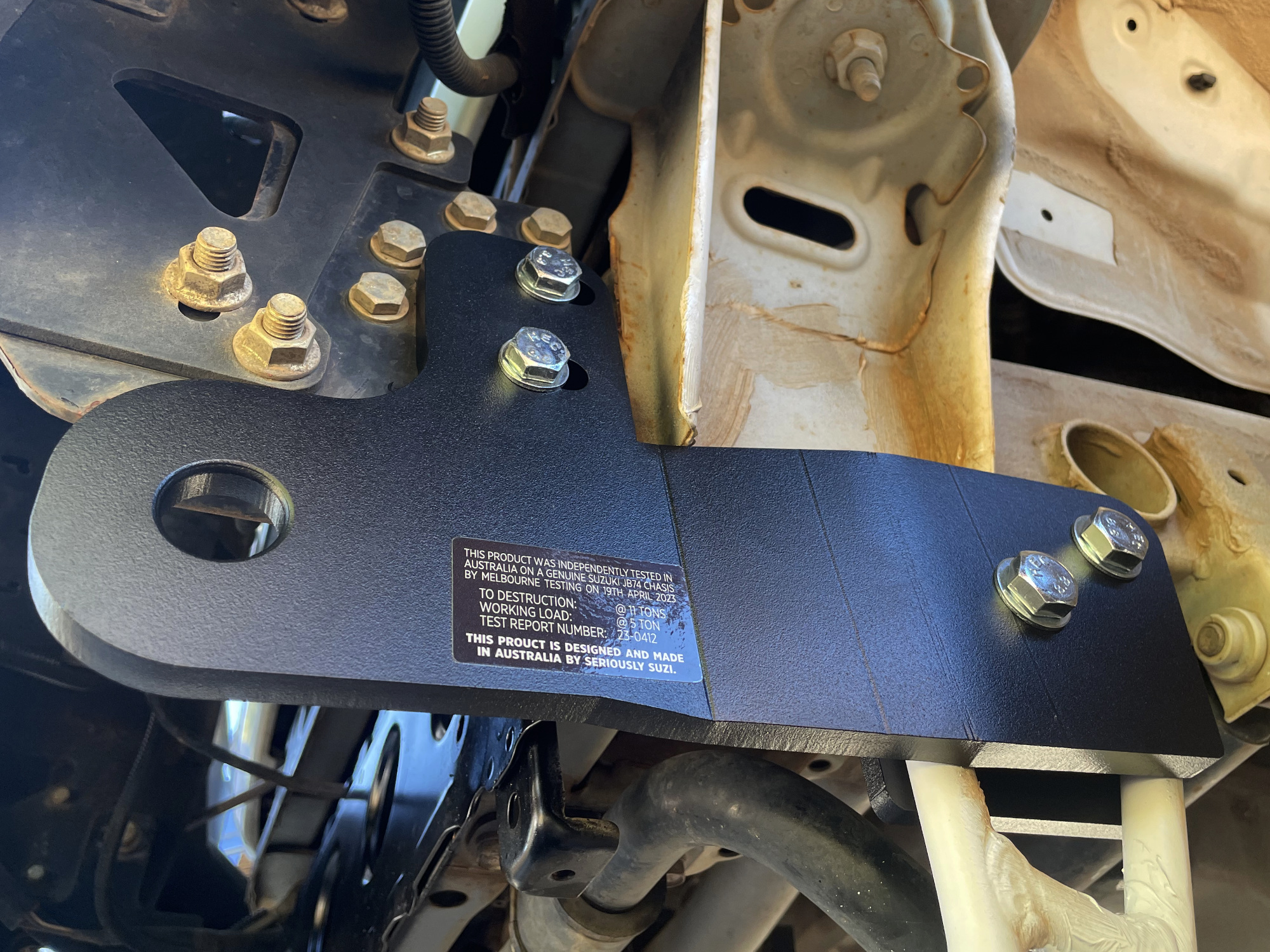
A lot of recovery points listed on websites are actually super thin steel and will either bend or break. They’re actually way weaker than the factory tiedown points, so don’t get suckered into buying cheap ones. If you have a bullbar then you can make the Ironman rated recovery points work with many of them, though Seriously Suzi make specific points for the ARB bullbar. I’d recommend these (and it’s what I now run).
If you have a factory bumper setup then you’re basically stuck with the BEI House recovery points which are pricey. You have to buy them from a store I generally haven’t got many things from, so that can be another consideration.
At the rear people might try to sell you recovery points integrated into a towbar. Personally I think they are not worth getting: the towbars are not attached any differently to the ones that don’t include the point so their strength to the chassis is identical to the cheaper and simpler ones without the recovery points. Just add a recovery hitch to your recovery package and you’re sorted. BEI House also make rear recovery points if you don’t want to run a towbar.
Roof storage
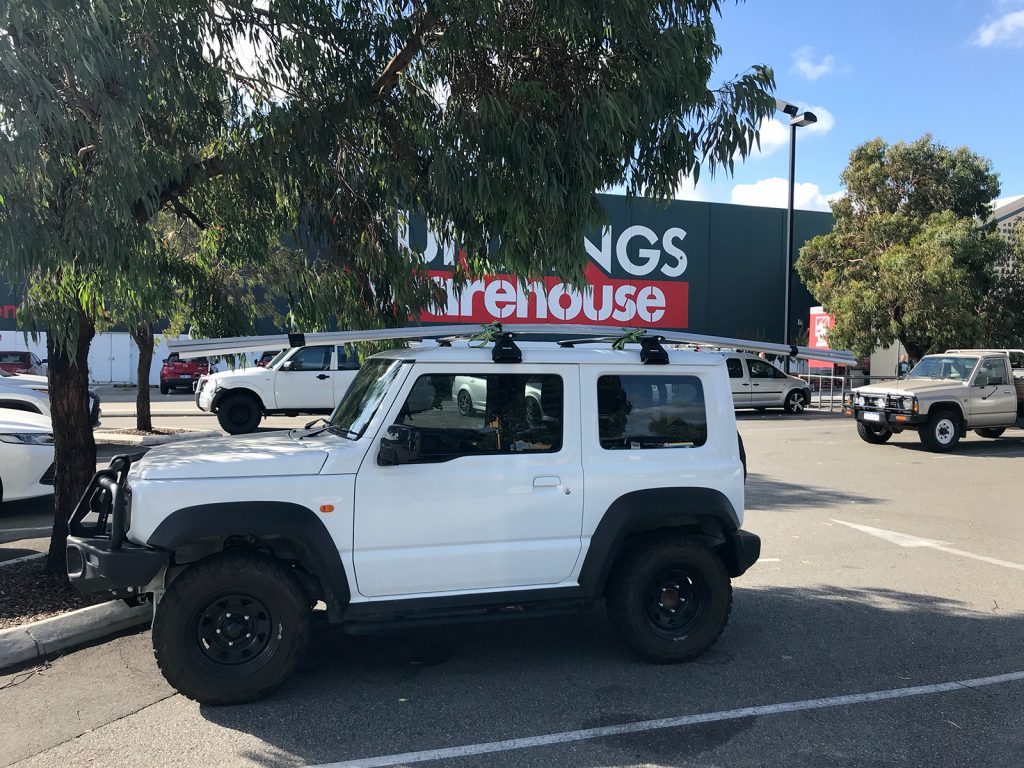
Unless you have a huge need for a flat platform, e.g. because you want to hold something large and bulky but unstructured up there, I would just get roof crossbars. First choice for me remains the Rhino Rack Vortex crossbars: they are light, very easily available in Australia, well priced with a huge range of accessories. Second choice would be the Skinny Jim roof crossbars, mostly as Jimny specialist companies are always good to support, but I don’t necessarily see compelling reasons to go for them.
If you are just looking to attach an awning to the car and literally don’t ever desire putting anything else on the roof then you can buy gutter mounts just for the awning itself.
Towbar/tow hitch
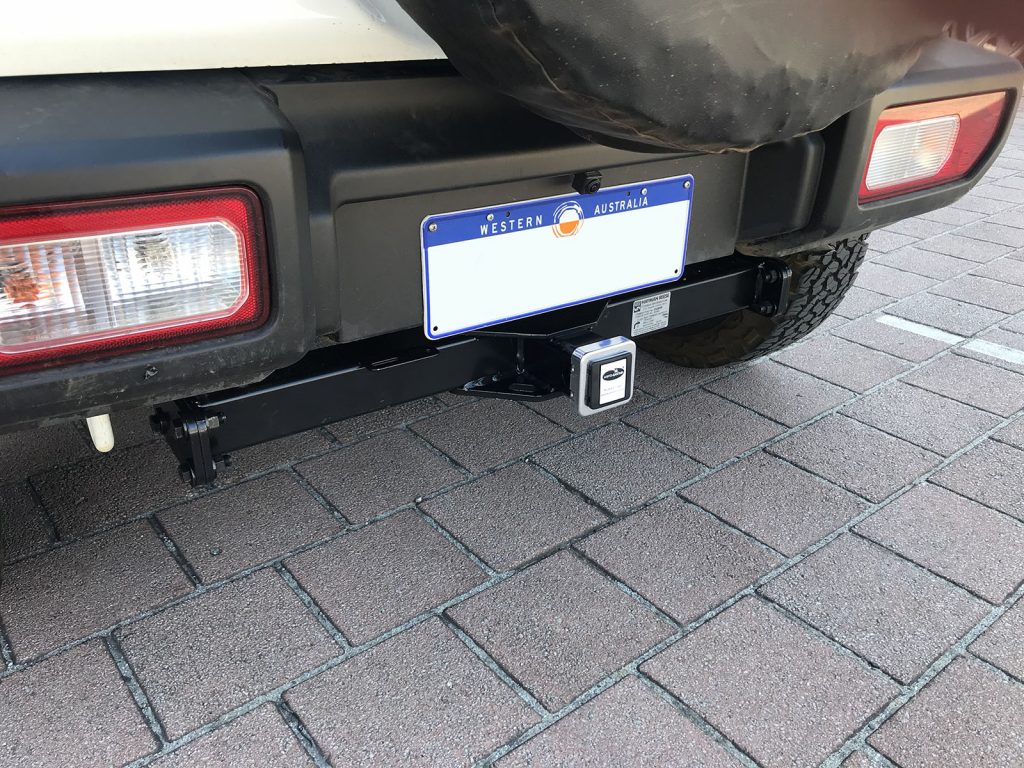
I discussed above about recovery point integrated towbars, and my preference remains to get the unadorned towbar. The factory Suzuki towbar pokes out a long way so I rule them out because of that; replacement rear bumpers are a significant investment of both money and weight so also not something I’m keen on. TAG make a pretty good towbar for the Jimny, but I’m very happy with my Hayman Reese towbar which is one of the first mods I fitted to my car in 2019. It remains my recommended towbar because it’s relatively low weight, but still appropriately strong, and tucks into the rear bumper nicely.
Seat covers
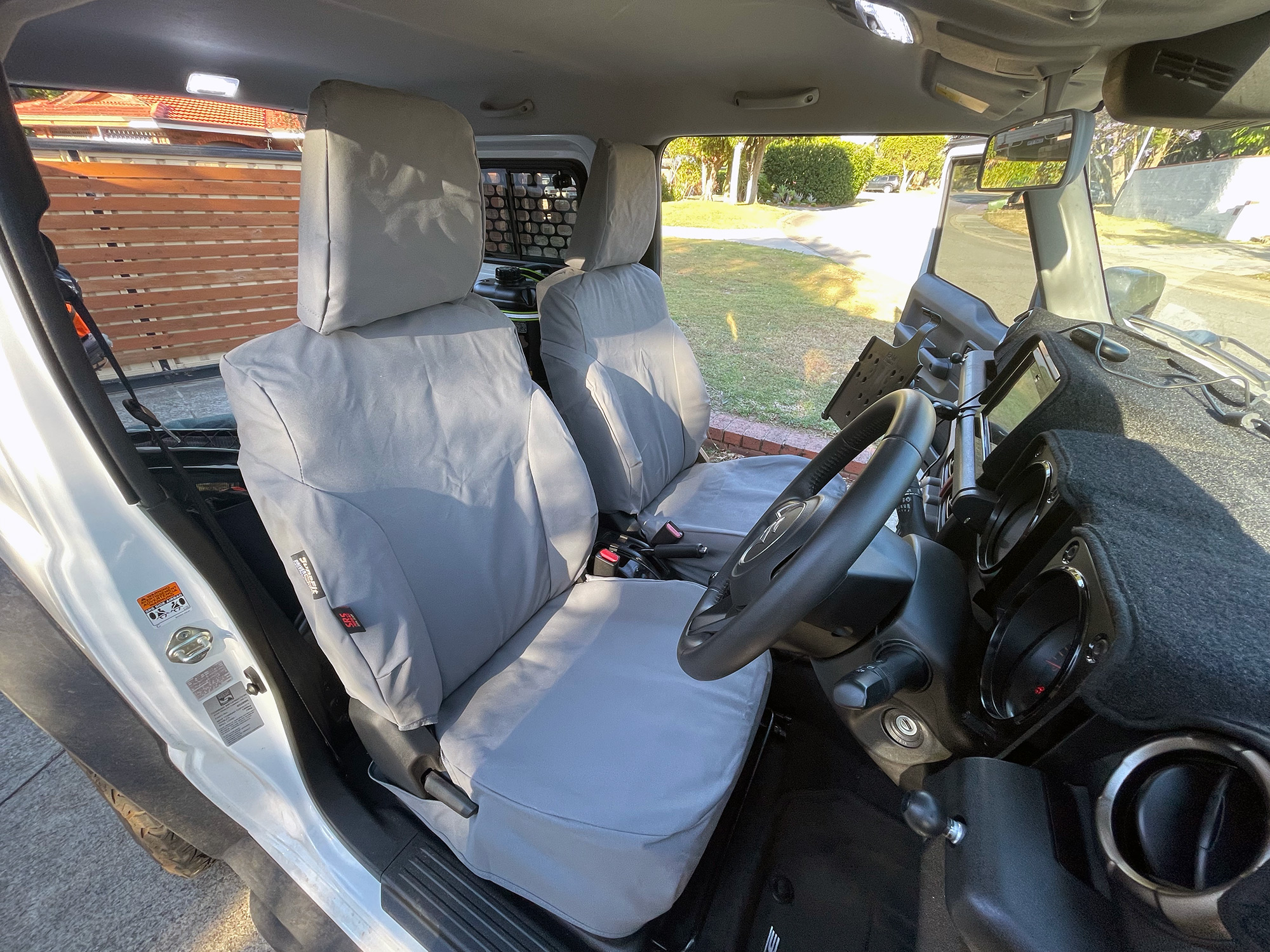
A huge consideration here is around the in-seat airbags. Generic covers are unlikely to properly fit, and some of the cheaper cover manufacturers say they are airbag compatible but rarely test them. My main recommended brand because of quality, longevity and also the Australian derived materials and 100% Australian on-site manufacturing are SupaFit covers for the Jimny seats. If you want a more fitted look then get their denim covers, but the canvas covers are also very well fitted and supremely comfortable, and also hard wearing.
If you want more of a leather look replacement and are prepared to go to the effort to properly fit them, then the Showa Garage covers, best bought via Compass Auto in Japan, are a good choice.
Floor mats, boot mat, dash mat
I really need to get pics of my mats, but my recommendation for floor mats are the 3D mats from Trufit. On the flipside I cannot recommend the factory rubber floor mats: they are very, very small and do not contain dirt particular well.
In terms of the rear area to protect the back of the seats, the factory rubber mat (part number 990E0-78R30-002) works well as one option, although I sold mine when I built a rear storage platform for my car. Amazingly ripoff versions of this sell for more than the genuine item from a dealership!
If you’re after an option to allow you to split fold the rear seats still then I’d get the Trufit version of the boot mat which allows for this.
For a dashmat I also recommend the factory dashmat (part number 990AA-00929-001). It has the correct cutouts for the sunload sensor for the climate control & the automatic headlights and again it’s cheaper than most of the aftermarket versions out there.
Interior storage
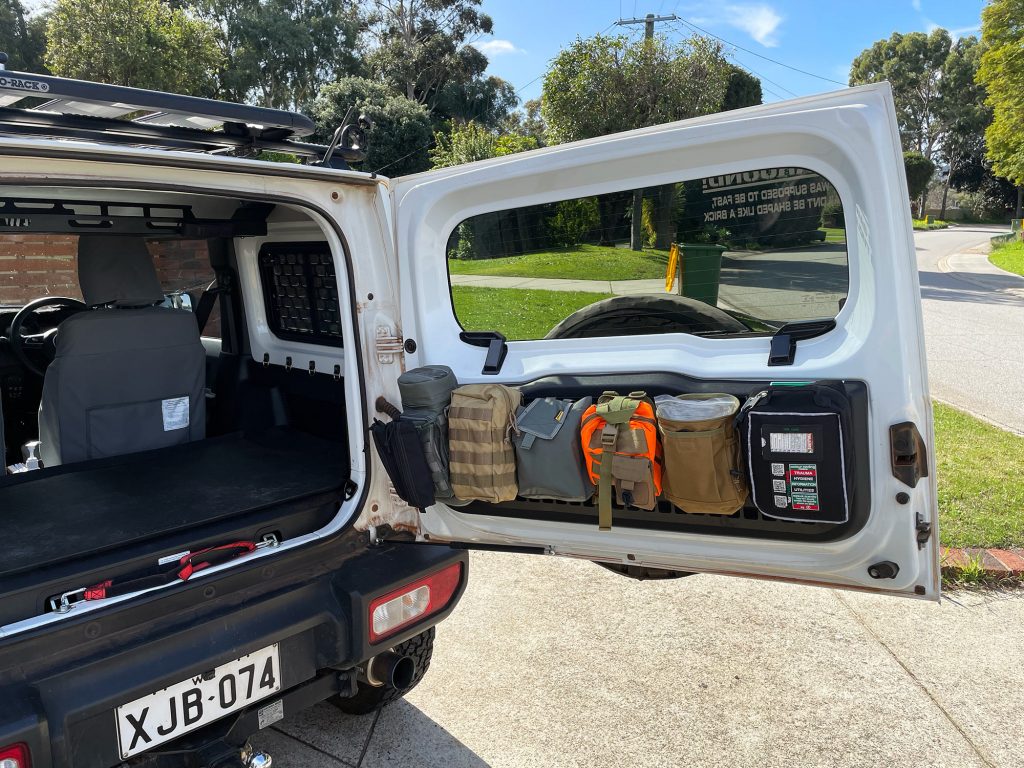
There are a huge range of choices for interior storage, but for me a couple of things come to mind:
- Having a rear door storage panel is fantastic and something I’ve used a lot.
- Roof level storage is super helpful. The TLR roof shelf is great, though no more or less compelling than the Kaon version. I’m also swapping over to the lighter/lower profile MOD roof hammock for storage of just lightweight things as I redesign my rear storage
- Get Good Gear make some really good molle equipment or other interior storage, such as a molle roof console for interior storage. I would get their stuff over the ripoffs on Aliexpress and/or various Jimny branded resellers.
- If you’re after a traditional roof console then Department of the Interior make a fantastic one for the Jimny, if you’re prepared to wait.
- Seat back molle panels are another great way to provide yourself flexibility around pouches at hte back of the front seats.
Recovery gear
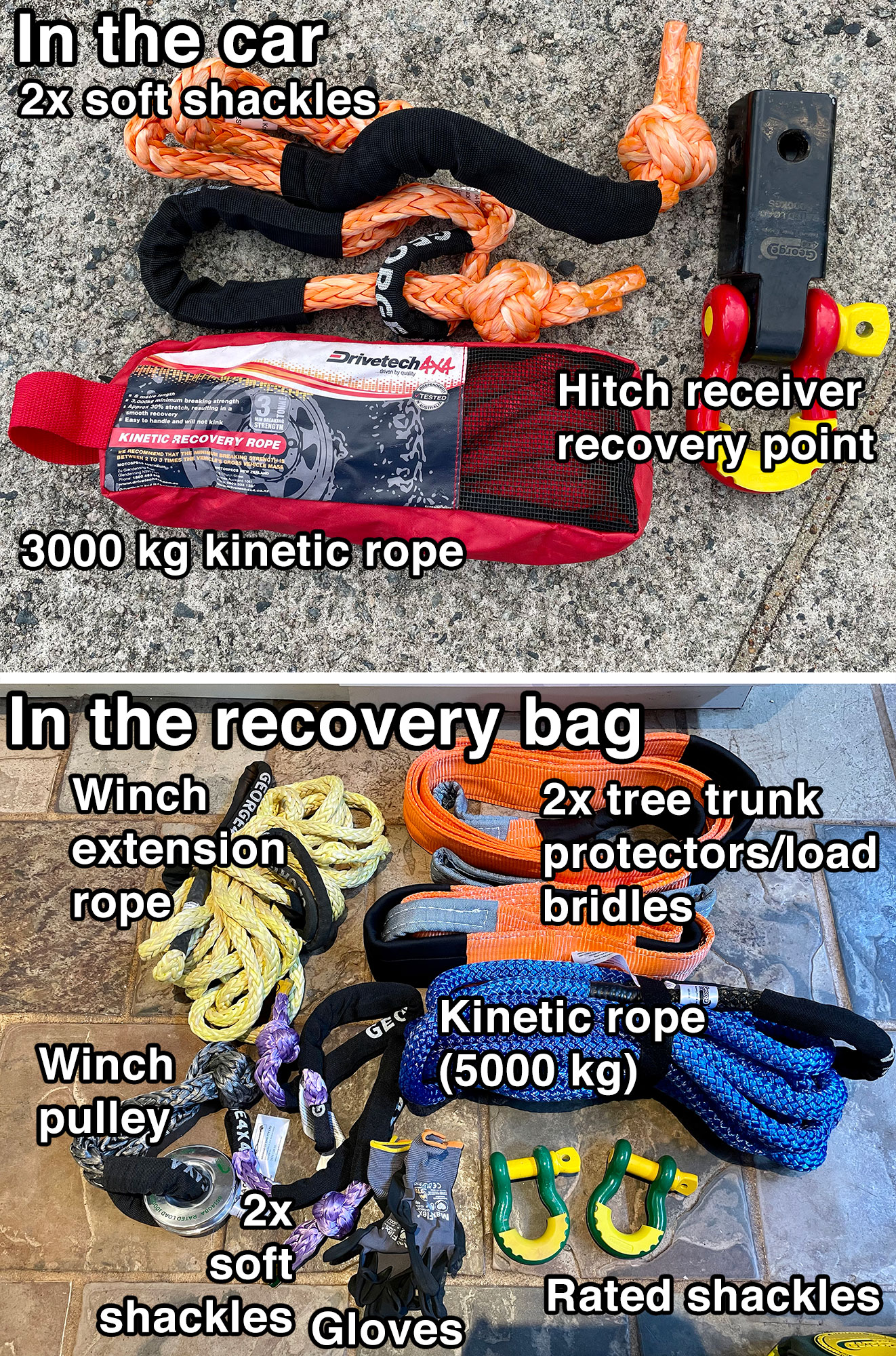
Very, very simple recommended place to get your recovery gear: george4x4 in Brisbane. He makes good stuff, and you can get things appropriate for the Jimny (e.g. kinetic ropes/snatch straps in the 3000-5000 kg range) through them. You don’t need as much as I have, even a couple of shackles and a strap or two will do, but it’s good to have.
Underbonnet air compressor & mount
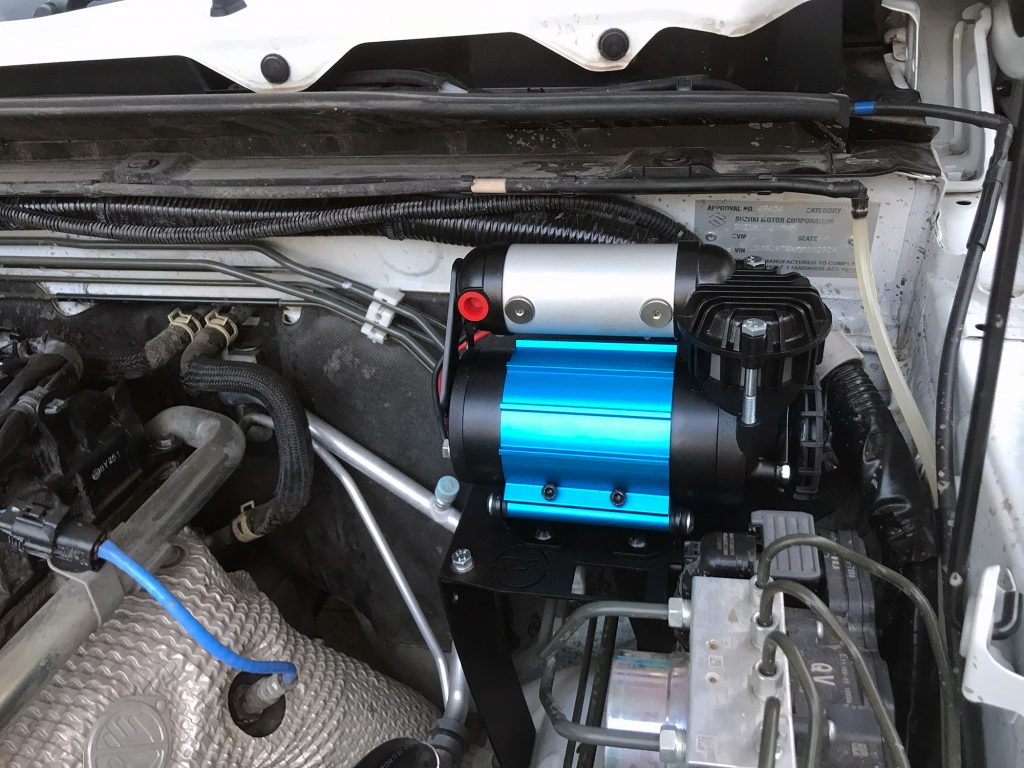
I’m a fan of having an underbonnet air compressor: there’s some unused space on the passengers side of RHD vehicles, and, it means I don’t have to find somewhere to stash a portable compressor.
While I have run the TLR underbonnet compressor mount for ages, I also like the design of the MOD equipment mount and will probably get one for myself to test. It gives a bit more flexibility for accessing the wiring grommet on the passengers side, which is nice, and will make a good mount for other things I hang off the bracket.
While the TLR mount is designed for the ARB single compressor, people have modified it to work with the TJM compressor. Zero compelling reasons for me to get anything other than the TJM compressor. The MOD underbonnet mount looks like it will work with a larger range of compressors. If you mounted a suitable heatshield to it then you could possibly use it for other things e.g. a small underbonnet-suitable battery would work there, too.
Openable back windows
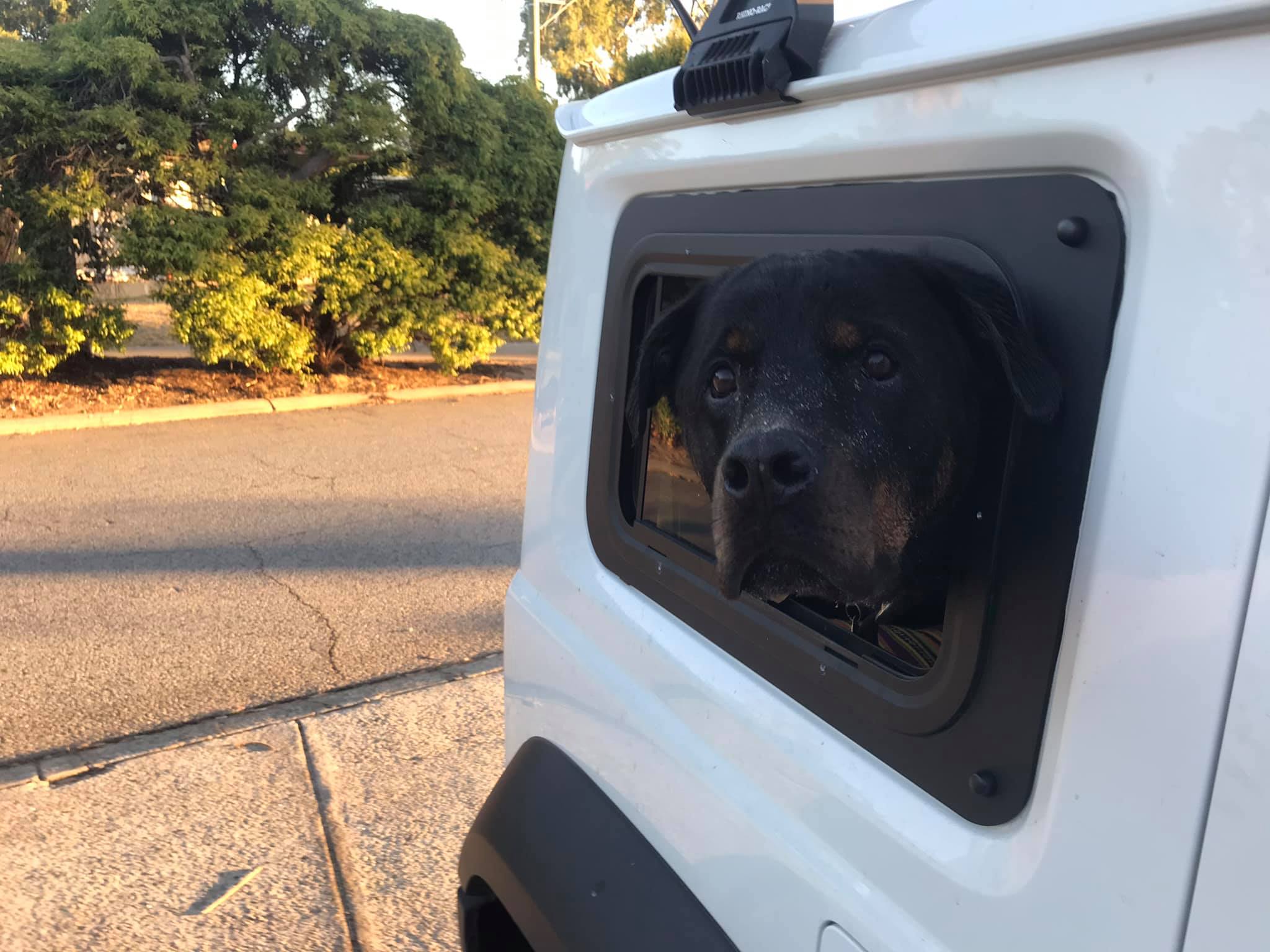
One choice for me for either sliding windows or gullwings: Explore Glazing out of the Netherlands. They lock better than other sliding windows, have optional accessories for the outside, and as a company they’re great to deal with. Although there are resellers of other windows in other countries, buying direct from the manufacturer means you aren’t stuck dealing with a drop-shipper middleman taking a bunch of the profit.
At some point I have a gullwing to swap into the drivers side for rear access direct from my shower tent, but before I do that you can read my DIY installation guide on the sliding windows. This guide applies to all sliding windows; I will stress, though, the quality of the Explore Glazing windows makes them well worth purchasing.
